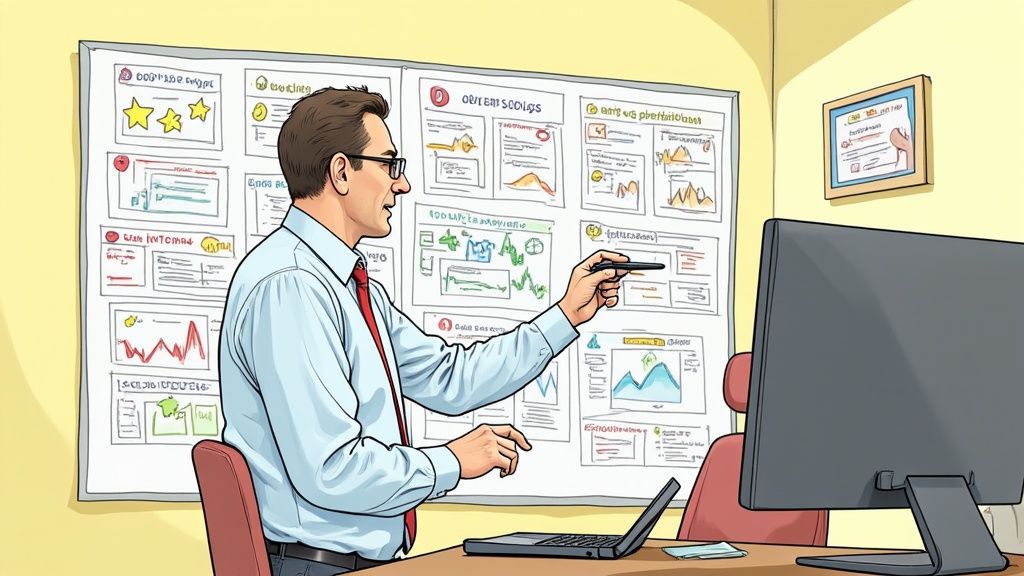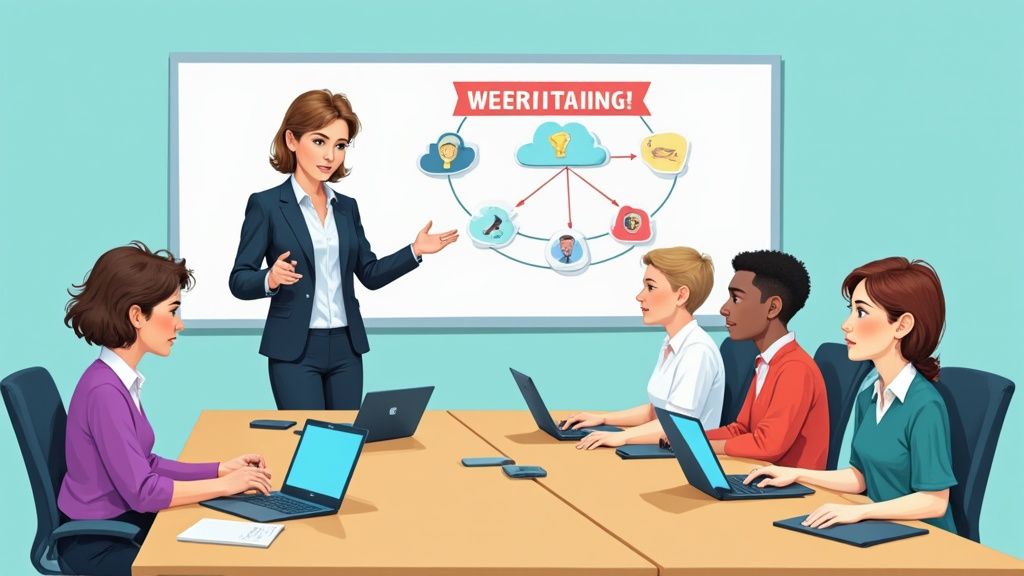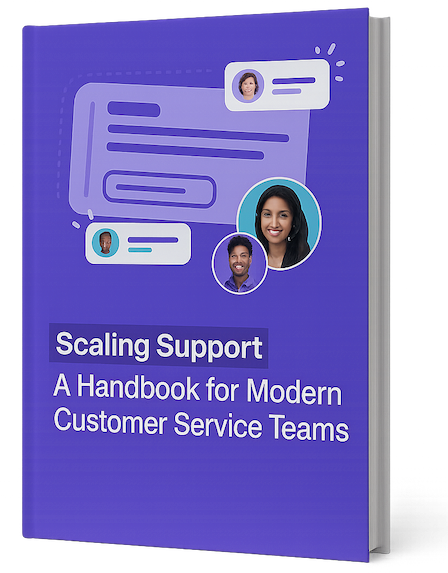Quality management in call centers directly impacts business success through improved customer experiences and loyalty. While many organizations view quality programs as basic compliance exercises, leading call centers use them strategically to drive real improvements in customer satisfaction and business outcomes. The key is understanding core challenges and measuring what truly matters.
Identifying the Core Pillars of Quality Management
Many call centers miss the mark by focusing only on basic metrics like handle time, rather than looking at the complete picture of customer satisfaction. For example, a rep might have quick call times but leave customers frustrated by rushing through interactions. True excellence in call center quality management requires building on three essential elements: empowering agents, maintaining strong quality assurance, and emphasizing first-call resolution.
- Agent Empowerment: Success starts with giving agents the right tools and authority to help customers effectively. Just like detectives need resources to solve cases, agents need thorough product knowledge, customer history access, and the ability to make decisions independently. This equips them to handle issues efficiently without constant oversight.
- Robust Quality Assurance: The best quality programs focus on growth rather than punishment. Think of QA as coaching that helps agents improve their skills. Regular constructive feedback, targeted development plans, and recognition of good work creates an environment where agents want to excel.
- First Call Resolution (FCR): Getting issues resolved on the first contact is crucial for customer satisfaction. Yet industry data shows FCR rates typically hover around 70-75%, indicating significant room to improve. Call centers must implement clear processes and give agents the support needed to handle issues completely in one interaction.
Linking Quality Management to Customer Loyalty
These pillars work together to create positive customer experiences that build lasting loyalty. For instance, when a customer calls about a complex technical issue, a well-trained agent with proper resources can solve it immediately. That smooth experience makes the customer more likely to stay with the company and recommend it to others. This shows how quality management directly impacts the metrics that matter most – customer retention and referrals that fuel business growth. By investing in quality systems that empower agents and streamline issue resolution, call centers can consistently deliver experiences that keep customers coming back.
Mastering First Call Resolution: Beyond the Basics

First Call Resolution (FCR) matters so much because it directly impacts customer satisfaction. When customers have their issues resolved in a single interaction, they walk away happy. But getting FCR right takes more than just understanding its importance – it requires specific strategies and an unwavering commitment to execution.
Understanding the Impact of FCR on Quality Management
Success in customer service ultimately comes down to solving problems quickly and completely. Just like you want a doctor to diagnose and treat your illness in one visit, customers expect support teams to handle their issues the first time around. While industry averages hover between 70-75% FCR, top performing centers consistently achieve 80% or higher. Research shows that even a 1% improvement in FCR leads to a corresponding 1% increase in customer satisfaction scores. This clear connection between efficient resolution and customer happiness makes FCR one of the most important metrics to track and improve.
Practical Strategies for Improving First Call Resolution
Better FCR requires giving agents the right tools and authority to succeed. Support teams need comprehensive knowledge bases and ready access to customer information to quickly diagnose and fix issues. Empowering agents to make decisions – like offering refunds without supervisor approval – speeds up resolution times. Data shows that around 60% of failed first-call resolutions happen because agents lack proper information or resources. Just as a detective needs evidence to solve cases, support teams need complete information and clear processes to effectively handle customer problems.
Creating a Culture of First Call Resolution
Building a culture focused on FCR means implementing clear processes, providing ongoing agent support, and establishing feedback loops to continuously improve. Setting up rewards for high FCR performance gives agents extra motivation to excel. Think of it like any skill – people improve faster when they have clear goals and recognition for achieving them. The key is maintaining a mindset of continuous improvement by regularly analyzing metrics, identifying bottlenecks, and adapting strategies based on what the data reveals. With sustained focus on these fundamentals, call centers can transform FCR from a basic metric into a true driver of customer satisfaction and operational excellence.
Transforming Quality Assurance into Strategic Success
Building on the foundation of empowered agents and first-call resolution, quality assurance (QA) has evolved beyond basic call monitoring into a powerful tool for ongoing improvement. The focus has shifted from identifying mistakes to actively developing agent skills through coaching and engagement. When implemented thoughtfully, this strategic approach to quality management reduces costs, strengthens customer satisfaction, and creates a culture where excellence thrives.
Rethinking Traditional QA Approaches
Many traditional QA programs fall short because they emphasize finding errors rather than supporting growth. This often breeds negativity, with agents feeling scrutinized instead of supported. Consider an athlete who only receives criticism about mistakes, with no guidance on technique improvements – their performance would likely suffer. Similarly, agents who feel constantly judged without constructive feedback become disengaged and lose motivation. By reframing QA as a development tool rather than fault-finding exercise, it becomes a positive force for change.
Building a QA Framework That Empowers Agents
Effective quality management programs put coaching and engagement first. This starts with creating a framework focused on continuous improvement rather than just compliance checking. Key elements include regular constructive feedback, targeted development plans, and recognition of good performance. For instance, instead of simply noting when an agent goes off-script, a QA analyst might suggest alternative phrasing and practice scenarios to help develop more natural communication skills. This approach helps agents take ownership of their growth.
Driving Performance Improvements Through Strategic QA
When agents view QA as a resource rather than a burden, they become more open to feedback and actively participate in improving their skills. This creates momentum toward a positive environment where agents constantly look for ways to deliver better service. Strategic quality management also helps identify broader issues affecting multiple agents. For example, if several team members struggle with the same type of customer issue, it may signal a need for updated training materials or process improvements.
Measuring the Success of Your QA Program
Evaluating the QA program itself is crucial for long-term success. This involves tracking key metrics like customer satisfaction scores, first-call resolution rates, and agent retention. Analyzing these data points reveals what’s working well and what needs adjustment. Like a gardener who regularly tends to plants, call centers must continuously refine their QA approach to maintain healthy growth. This ongoing improvement cycle ensures consistently high-quality customer experiences while meeting business objectives.
Balancing Metrics That Drive Real Results

Managing a high-performing call center requires striking the right balance between efficiency metrics and customer experience. While measures like average handle time (AHT), service level, and occupancy rate help optimize operations, they shouldn’t overshadow the core mission of keeping customers happy. This section examines practical ways to achieve results across both operational and customer satisfaction goals.
Optimizing Handle Time Without Sacrificing Customer Satisfaction
The industry average handle time of 6 minutes and 10 seconds serves as a useful benchmark, but focusing solely on reducing this metric can lead to rushed, low-quality interactions. The key is finding ways to help agents work efficiently while still providing great service. For example, giving agents quick access to knowledge bases and customer data helps them resolve issues faster without cutting corners. Simple process improvements, like removing unnecessary steps, can also trim handle times naturally without pressuring agents to rush.
Maintaining Healthy Occupancy Rates and Preventing Burnout
A healthy occupancy rate between 80% and 85% ensures agents stay productive without getting overwhelmed. When occupancy climbs too high, agent burnout and turnover often follow, directly impacting customer experience. Smart workforce management is essential – this means implementing flexible schedules, providing enough breaks, and maintaining proper staffing levels to handle fluctuating call volumes. Regular monitoring helps catch occupancy issues before they affect team morale and performance.
Meeting Service Levels Consistently
Service level goals, like answering 80% of calls within 20 seconds, indicate how responsive your center is to customers. Meeting these targets takes more than just hiring more agents. Success requires optimizing call routing, offering callback options during peak times, and using data to predict and prepare for volume spikes. Tools like SupportMan provide real-time visibility into customer satisfaction trends, enabling managers to quickly adjust staffing and processes to maintain service levels while delivering quality care.
Aligning Metrics with Business Objectives
Your metrics must support your company’s broader goals. Different businesses will prioritize different measures based on their strategy. A company focused on customer retention might emphasize first-call resolution and satisfaction scores over handle time. Meanwhile, a cost-conscious operation may need to optimize handle time and occupancy. The key is choosing metrics that match your specific objectives and regularly reviewing performance against those goals. Taking this balanced approach helps call centers achieve both operational efficiency and excellent customer experiences.
Using Technology to Improve Call Center Quality

As call centers aim to improve quality management, technology offers powerful ways to enhance operations beyond simple automation. Modern tools and data insights help teams identify improvement areas and enable agents to deliver better customer experiences. Let’s explore how technology can strengthen call center quality programs.
AI-Powered Quality Monitoring: Moving Beyond Sample Reviews
Traditional quality programs that manually review a small percentage of calls only provide limited visibility into overall performance. AI tools can analyze 100% of customer interactions, uncovering important patterns and trends that random sampling would miss. For instance, AI identifies common issues customers face, areas where agents need support, and changes in customer sentiment over time. This data helps managers provide focused coaching on the specific skills that will most improve service quality.
Automating Tasks to Focus on High-Value Work
Smart technology helps remove routine tasks so agents and managers can concentrate on meaningful customer interactions. Call routing systems direct customers to the best-suited agent, while chatbots handle basic questions. This gives human agents more time for complex issues that require a personal touch. When agents can focus on having quality conversations rather than administrative work, they provide more attentive and caring service – which builds customer loyalty.
Selecting the Right Technology: A Strategic Approach to Call Center Quality Management
Choosing technology requires careful planning to maximize value and ensure smooth integration with existing systems. For example, SupportMan connects customer feedback directly to Slack for quick team communication and issue resolution. The key is finding tools that enhance rather than replace human capabilities. While AI excels at analysis and automation, person-to-person service remains essential. The goal is balancing technology and human skills to drive real quality improvements.
Overcoming Implementation Challenges
Rolling out new technology comes with obstacles that need proactive management. Agents may feel uncertain about changes to their workflow and tools. Clear communication, thorough training, and ongoing support help ease these concerns. Data security is also critical since call centers handle sensitive customer information. By addressing implementation challenges thoughtfully, call centers can use technology effectively to strengthen quality programs and help agents deliver outstanding service. Over time, this leads to higher customer satisfaction and a more engaged workforce.
Creating a Culture of Continuous Excellence
Building an effective call center quality management program involves creating an environment where quality becomes a natural part of every interaction. Success comes from moving beyond just tracking metrics to fostering an atmosphere where the entire team embraces quality as their shared mission.
Engaging Agents in the Quality Process
Getting agents actively invested in quality improvement makes a huge difference. Rather than treating quality assurance as something punitive, position it as a collaborative growth opportunity. In feedback sessions, balance recognition of strengths with constructive coaching on areas to develop. For instance, instead of simply pointing out missed opportunities, role-play scenarios together and share practical tips, like natural ways to introduce additional products during conversations. When agents feel genuinely supported, they become more engaged in their own development.
Developing Effective Feedback Loops
Communication needs to flow both ways to drive real improvement. Set up regular channels for agents to share their perspectives, whether through team meetings about common customer issues, online forums for best practices, or anonymous surveys about processes and tools. By listening closely to agents’ firsthand experiences, managers can spot pain points and opportunities to enhance training and workflows.
Creating Sustainable Performance Improvements
Like an athlete training consistently, call centers need ongoing analysis, refinement and adaptation based on real results. Focus on setting clear, achievable goals – for example, targeting specific First Call Resolution (FCR) improvements through targeted training and support. Even small gains compound over time to noticeably boost customer satisfaction.
Fostering a Culture of Ownership and Accountability
At its core, excellence stems from every team member feeling ownership of and accountability for their performance. This means giving agents both the responsibility and the resources to succeed, like easy access to knowledge bases and customer information so they can efficiently resolve issues. When agents feel equipped and empowered, they naturally become more engaged in delivering great service. SupportMan can help facilitate this by providing real-time feedback and enabling collaborative performance discussions. Experience how SupportMan can transform your call center into an environment of continuous improvement – try it free today at https://supportman.io.


